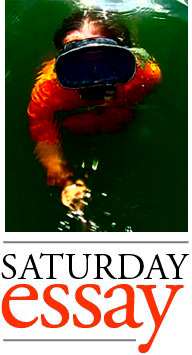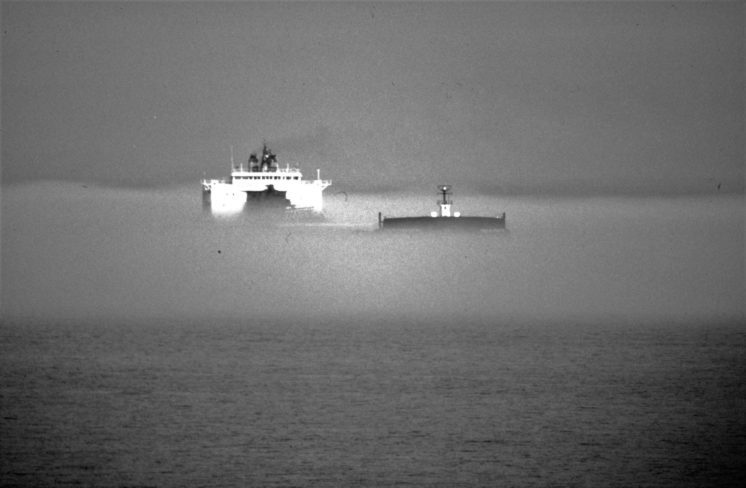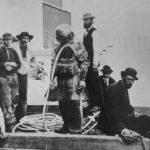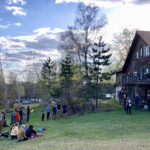The Janus, Ghost Ship of Lake Superior
 The MV Sophia F. Janus was built, launched, and christened in 1977. It was among the first of 13 “thousand-footers” to sail the inland seas: 1013 feet long, 113 feet wide, 566 feet hull depth, containing 1,300 tons of oil for its four-story engine. It could carry more than 90,000 tons of cargo, with a crew of 23 souls. The ship was an innovative mixed-use tanker-bulk hauler, with three chemical tank holds and two bulk holds. It had a 250-foot discharge boom for the self-unloading of bulk cargo at a rate of 6,000 tons per hour. The vessel holds numerous cargo records. In the superstitious lore of the sailors, however, because a dock worker was crushed during launch, the Janus was considered cursed. Even the infinite dilution of the Great Lakes could not dissolve the stain of blood.
The MV Sophia F. Janus was built, launched, and christened in 1977. It was among the first of 13 “thousand-footers” to sail the inland seas: 1013 feet long, 113 feet wide, 566 feet hull depth, containing 1,300 tons of oil for its four-story engine. It could carry more than 90,000 tons of cargo, with a crew of 23 souls. The ship was an innovative mixed-use tanker-bulk hauler, with three chemical tank holds and two bulk holds. It had a 250-foot discharge boom for the self-unloading of bulk cargo at a rate of 6,000 tons per hour. The vessel holds numerous cargo records. In the superstitious lore of the sailors, however, because a dock worker was crushed during launch, the Janus was considered cursed. Even the infinite dilution of the Great Lakes could not dissolve the stain of blood.
Communication was lost with the Janus in a storm in 1982, and it appeared to have sunk without a trace after leaving Duluth. No flotsam, oil slick, or fuel spill was discovered in the area of her last known location, which was the middle of Lake Superior.
In the absence of evidence, competing theories developed that seemed equally plausible. According to one, the ship bottomed out on unmarked shoals, causing hull stresses exploited by the twisting forces of rolling waves. If the torsion corridors buckled, the steel hull would have shredded and dipped for the bottom.
Other theories focused on the human dramas. Some reasoned the Janus might have suffered a power failure, but the Captain would not give the order to abandon ship — the crew then panicked and launched the lifeboat, which itself went down. Some whispered the word “mutiny.”
Complicating matters, the ship’s registration and ownership fell into legal limbo. It was not even possible to determine what the Janus was carrying in the holds on its final voyage. This led to claims about hidden manifests, forged documents, and falsified names. Some corners of the conspiracy-verse argued it was a black ops mission gone wrong. Some speculated the ship never existed at all.
However, reports of sightings accumulated after the 1982 storm. Years apart, the pattern was difficult for researchers to detect. But initially dismissed reports gained a critical mass. A notable claim from the Vista Queen in 1994 alleged an encounter in the rain, and a conversation across the void with a Janus crewman who tried to pass letters to his mother and his wife — both long dead. The Vista Queen, a known party barge, torpedoed its own credibility. But amid a range of such fragmentary information, some serious researchers started believing the Janus hadn’t sunk at all. Could it still be floating around out there, abandoned, a ghost ship congealing myths around itself?
The idea of salvage took hold. Since 1997, I can document five boarding and salvage attempts. In each case, boarding teams were either unprepared or driven away by bad weather. Many salvagers were lost in these dangerous attempts to board and seize the ghost ship. The Janus stripped crew from those who encountered it, adding them to its own phantom roster.

“,,,we attempted salvage of the abandoned ghost ship Janus in heavy fog…”
Boarding #1. November 12, 1997
From the report of First Mate Gerhard Fletcher of the MV Sonoma Star.
We spotted and identified the Janus riding low to the water and drifting in circles northeast off Marquette MI. We plotted an intercept, approaching as the wind picked up. Drawing closer, we determined her lifeboat was intact and had not launched. Ship’s anchors were gone. The beheaded cyclopean chains clanged against the bow like the tolling of woeful bells. The hawsepipes looked like eye sockets in a skull, chains swinging loose like severed optic nerves. We also spotted snapped tow lines indicating someone preceded us, had tried hauling her in rough seas, and failed.
We lashed ourselves to her port side. Boarded the derelict with great anticipation even under the gathering thunderhead eating the low sun. Very dangerous work. With me were six officers and able seamen, our job to access the navigation bridge, determine if the ship had power, and perform a full systems check. If dead we would try to tow her but time was short.
Amid creaking ship noises, we peeked in the gray officers’ mess hall with our flashlight beams and found tables set for dinner 15 years ago.
Reaching the bridge, we verified the rudder was locked hard to starboard. No power. Noted the gyrocompass was missing from the wing deck. All at once the discharge boom slipped its moorings, and the great arm swung 90 degrees to starboard. It locked into place with a metallic clash like a gong. The boom pointed into the gyre like a cataclysmic clock hand had ticked forward.
State of the Captain’s Quarters: Captain Simon Battle’s body sits desiccated at his desk, shot himself rather than abandon ship. Perhaps the crew mutinied at his order to remain on board. But the lifeboat has not been launched? Pictures of Battle’s family all around. I served with him in the Merchant Marine and recognized their faces frozen in the past. Logbook’s mysterious final entry suggests everything was fine on the morning of. Contains the line: “We shall deliver our cargoes if it takes until the day of judgement, in spite of the devil.” Which devil was he thinking of? Anomalous pile of boots in his quarters — no reason he should have collected all these different sizes. Had the crew abandoned ship barefoot?
Second Mate Flannery inventoried the Janus’ life vests, life rafts, lifeboat, and the other safety equipment. He reported to me in Battle’s quarters that it was all untouched except for one thing: the hatchet was missing from the lifeboat.
I retrieved the cargo manifest from Battle’s desk. It shows a typical mixed load for this versatile vessel:
Cargo Hold 1: 17,000 tons of steel plates for the shipyards of Chicago
Cargo Hold 2: 16,000 tons of bulk soybeans for Ontario
Cargo Hold 3: 18,000 tons of diesel fuel for Thunder Bay
Cargo Hold 4: 16,000 tons of dry ice for Detroit
Cargo Hold 5: 17,000 tons of ethanol for Sault Ste. Marie
One possibility is that an accident flooded the dry ice hold with ethanol, filling the ship with alcohol vapors. The Janus would have become a gigantic smoking Halloween martini within moments. If so, many crew asphyxiated in the belly of the ship, or became dangerously drunk quite suddenly and toppled over the side. They would be the lucky ones. Any survivor would suffer brain damage, oxygen deprivation, or permanent intoxication.
We started feeling pretty drunk ourselves with waves smacking the hull. I ordered us to disembark before we could search all 13 decks and the cargo holds. A slow leak between holds may keep the ship saturated with alcohol vapor which is at first undetectable in the upper decks. But the density of the vapors increases progressively into the lower decks, then you’re already lost. Presumably that’s where the bodies of the crew lie. But we abandoned our effort in rough seas, cutting ties. Last saw her drifting into the storm. Captain Battle has not finished his final voyage, a ferryman transporting the dead. Only then did we realize we were absent a crew member, young Jacob Messer, talented engineer — now officially lost at sea. Unofficially, a crewmember of the ghost ship, navigating the other side.
Boarding #2: March 8, 2004
From the notes of Second Mate Bill Montgomery of the USS Little Rock
We pulled alongside the Janus in the 24-foot cutter and climbed the hull using the pilot ladder. Story of abandonment remains unknown. Signs of habitation on the bridge. Possible lone survivor, a Robinson Crusoe marooned on his own deserted cargo ship. Salvage ideas abandoned as we had been caught unprepared for the complex effort. Once we realized deck hand Mayweather had disappeared and was assumed fallen overboard, we returned to the Little Rock and performed a Search and Rescue operation. We sailed an expanding square search pattern and covered the surface of the sea with our searchlight beams all night. We failed to find a trace. We were forced to consider perhaps they had succumbed to the anoxic atmosphere of the Janus. We attempted returning in the morning but the phantom ship had drifted off our radar screen.
Boarding #3: December 14, 2010
From the journal of First Mate Harold Dugan of the MV Crammenfjorder
Surveyed the navigation bridge to find all controls stripped by goddamn graverobbers. Same situation in the engine control room. The place is skeletal, you could build a whole other ship with what’s not there. The superstructure shows massive water damage if not outright flooding: many windows broken, rust and mold everywhere. Captain Battle’s mummified body if it ever really existed has been washed away. The rogue salvors appear to have smashed windows on their way out as an act of sabotage; wind and rain and punishing wave action did the rest. Lower decks dry as a bone.
Difficult to feel it wasn’t haunted. Chief Engineer Swanson swears a black dog startled him dashing by in the dim corridor outside the ballast and cargo control room. We fled back to the Crammenfjorder and radioed the Janus’ position to the Coast Guard, but they failed to intercept it before it vanished between the hemispheres of the horizon.
Boarding #4: January 4, 2012
From the report of Captain Elsa Wan of the MV Roger Penrose
In the rough open waters south of Siskiwit Bay, we attempted salvage of the abandoned ghost ship Janus in heavy fog. It was rolling terribly. Boarding was virtually suicidal, its discharge boom was swinging side to side like a great metronome. But I felt a moral responsibility to secure her diesel cargo no matter the risk — it is a loaded gun pointed at the environment. Boarding party of eight was transferred ship-to-ship using our cargo crane and a marine personnel transfer basket. The crane operator had to match the rolling of the Janus to set us down. Even so I broke my elbow as we hit hard on a hatch cover. Nevertheless, we secured the boom with mooring ropes, then split into two four-person teams connected by walkie-talkie.
We immediately encountered confusion between decks. Not only was I in blinding pain, but both teams felt seasick, and we had difficulty determining which decks we were even on. We thought we were stepping into Deck C only to find ourselves walking into Engineering. In the torsion corridors, we thought we were heading fore but wound up heading aft. Ethanol contamination worse than reported. The tasteless vapor sloshed around like an invisible fluid, unseen waves breaking over us even in the open air on the main deck.
I lost First Mate Charles Wilkins as we milled about the aft mooring fixtures waiting for Team 2 to find their way out of the Galley. Wilkins stepped behind a winch and never reemerged as if he took a wrong step into inner space. Assuming he went overboard, we abandoned our salvage attempts. Our heads cleared as we reached the Penrose, watching the Janus drift sideways into the chop and mist. We began SAR operations to locate the First Mate, but he remains lost at sea. I do not relish having to break the news to Rev. and Mrs. Wilkins — Charlie was their only child.
Boarding #5: August 30, 2017
Notes of Stephen Littlewolf, First Mate of the USCGC Alder
Even wearing self-contained breathing apparatus, the atmosphere of the Janus is an intoxicant. It smacks of a Ballardian madman remaking the ship to correspond to his desires. The Janus has become a map of his subconscious mind full of trick Ames rooms, hidden chambers, secret doors, and passages booby-trapped with optical illusions. We found steel plates from Hold #1 burnished into perfect mirrors in the workshop. I believe they are installed throughout the ship to confuse directionality. The ship has been rebuilt from the inside to include diverging parallel lines, corners that resolve into open doors, and skewed angles confounding distances. The labyrinth shifts vertiginously with every step defying the dreams of Euclid. This explains how people enter and never return, the way Cthulu’s R’lyeh swallowed wayward sailors into its counterintuitive geometry. The Janus’ original crew could still be alive, living on board for decades, unable to find their way out as if trapped in a book of Escher.
Defying orders, ensign Roback attempted a limited search by attaching a tether above decks so she wouldn’t lose her way in the branching bulkheads. But we found her line severed, moved, and re-tied off deep within the ship’s confusion. It’s possible she cut her own rope, re-tying the umbilical to establish a new center. But the interior contains more surface area than the exterior. Like the universe there is no true center.
Trying to find Roback, we discovered a secret navigation bridge below decks which fails to appear on the schematics. Now that we’ve found our way to the main deck again, we can’t work out where on board it actually was, like my dream of finding a new room in the old house. Could a remaining survivor pilot the vessel from this hidden control room?
Then, our officers found a space installed under a false floor in the cavernous Cargo Hold 2. The vast ceiling of this esoteric chamber held full-spectrum grow lights on an overhead track, an inner sun belying that the ship had no power. Fertile soil had been established to a depth of several feet to accommodate a fruit orchard and a vegetable farm, grown presumably from seeds in the galley’s produce: colorful squashes and peppers. The hold had been painted with a 360-degree mural depicting the vault of heaven and celestial bodies along distant azimuths. On a manicured path flanked with sunflowers and purple amaranth we found the ship’s missing gyrocompass. It stood displayed like an ornamental sundial in a Roman garden, determining mysterious headings unrelated to true north. A cathedral-like feeling in there. We had thought maybe a single Robinson Crusoe still roamed the brachiating interior volumes. But from the looks of the garden, generations of people live in a false Eden. Some may even be buried there. It’s possible the body of Captain Battle is interred nourishing the crops of this strange culture that developed in isolation.
The horizon spun around the vessel and we had to abandon it.
We installed a GPS tracker on our way out, and a helicopter from the Traverse City Air Station was dispatched to intercept. But the signal failed within the hour as if the Janus had sailed inside itself.
Message in a bottle, found in Grand Marais on 5/4/21 and turned over to the Minnesota Historical Society:
[First few words illegible from water damage] … cracked the code of the Janus, seen its hidden face. Under the command of no one and nothing, the ship assumed a leviathan presence. The crew never left, developing their own freedoms in isolation. The hive-mind united through the vapor permeating like a shared frame of reference. They mastered the conversion of ethanol into acetylene and used the steel plates to install an inner hull camouflaged by the forking paths and the hall of mirrors imaginarium. The vegetal hulls from the soybeans are combined with sludge from the ship’s sewage treatment plant to make rich compost. Eden springs anew. The crew subsist and even flourish, hidden from the face of the world, numbers replenished by defectors, wanderers, and alcoholics … [illegible] … The ship is a giant key… [illegible] … twin faces of the Janus, here on the precipice of the maze of multiplied perspectives, I venture in. Tell my wife I love her very much. The now double-hulled vessel is a ship within a ship. Perhaps it is an infinity of nesting ships. The space between hulls may be flooded or emptied regulating buoyancy like a submarine, the sea opening its inner dimension as we fire up the engine. Throwing this message overboard and sealing the hatch behind me, we dive. Signed, [identity obliterated]
(All my essays here.)
Recommended Links:
Leave a Comment
Only registered members can post a comment , Login / Register Here














No Comments